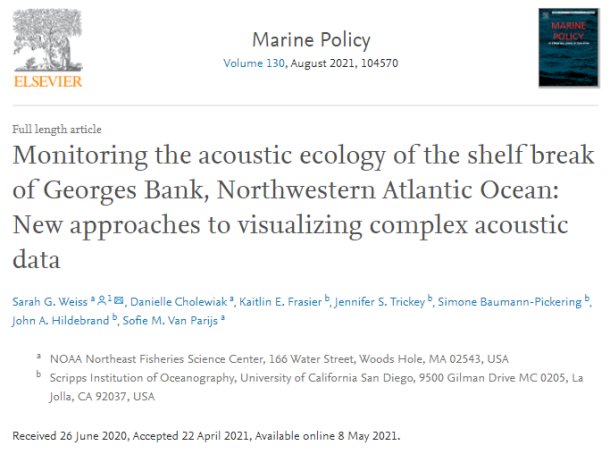New publication on acoustic ecology and visualizing complex data
Posted on May 13, 2021
Abstract
Within a soundscape, anthropogenic sound often dominates frequency ranges used by various species, leading to signal overlap and potential communication masking. The acoustic niche hypothesis predicts species will avoid competition by vocalizing at unique bandwidths. To evaluate the extent of anthropogenic overlap, it’s helpful to understand acoustic niches across time. This study aims to assess the co-occurrence of cetaceans and anthropogenic activities, presenting simple and accessible visualizations of the temporal and spectral overlap. Continuous passive acoustic recordings from 10 Hz to 100 kHz were collected near three deep-water canyons (Heezen, Oceanographer, and Nantucket) along the continental shelf break of Georges Bank between April 2015 and March 2016. Daily presence was documented for five mysticete species (North Atlantic right, fin, blue, sei, humpback), five odontocete species and/or groups combined according to primary frequency ranges (delphinids, sperm whales, Kogia spp, Sowerby’s, and Cuviers’/True’s/Gervais’ beaked whales), and four anthropogenic activities (airgun noise, broadband ship noise, echosounders, and explosions). At each site, cetacean and anthropogenic sources were found to be significant contributors. Individual cetacean species/groups were present from 2% to 100% of days across sites, with delphinids, sperm whales, and fin whales detected most consistently. Airgun noise, the most frequently detected anthropogenic signal, ranged from 50% to 91% of days across all sites, followed by broadband ship noise (15–65% of days), echosounders (1–14% of days), and one explosion detected at Oceanographer Canyon. This approach allows for broad comparison of species and anthropogenic activity, providing understanding of variability in acoustic overlap and potential masking between sites.
https://doi.org/10.1016/j.marpol.2021.104570


